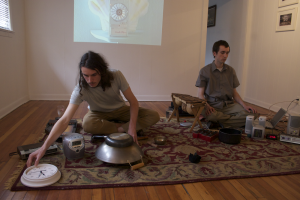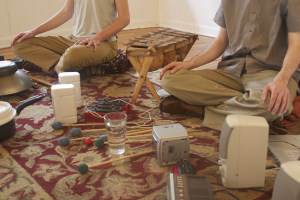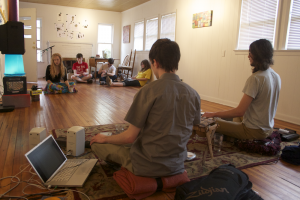2005(1)
Manfred Werder
(score)
Manfred Werder (b. 1965) is a Swiss composer whose work addresses the basic elements of musical and auditory experience. His process of relieving musical materials is articulated most elegantly in his recent series of compositions, beginning with 2005(1). The score contains only six words: “ort/zeit/( klänge )” as well as the English “place/time/( sounds )”. He has since created more pieces in this series, all titled after the year and rank of the composition within that year and each focused on the ability of his text scores to create awareness of an environment that we simultaneously inhabit and create for ourselves.
On March 13th, 2011, anteroom performed 2005(1) at Tex Gallery in Denton, TX during the 35 Conferette, an annual event featuring independent music acts from across the country. Our interpretation resulted in a three hour performance of the work informed by three views of the score. First, a linguistic analysis of the English half of the score, which lead to multiple readings of its content through implementing different interpretations of the grammatical and syntactic structure of the score itself. Second, an understanding of the performance practice of Werder’s recent series of works through previously recorded documentation and literature; and finally, a concern for the appropriate place and time for the delivery of 2005(1) as manifested in the 35 Conferette event.
Our performance was divided into three one hour sections, each addressing a different linguistic interpretation of the score. During the first hour, place was interpreted as an imperative verb, and time-sounds as a compound noun resulting in a score that instructs the performers to place, or arrange, time-sounds. This section was realized by placing various ticking clocks in the gallery, as well as arranging for a few electronic alarm clocks and clock radios kept at minimal volume to sound off periodically within the space.  We chose intuitively when to activate the snooze feature on each sounding clock, allowing the unique characteristics of each device to determine its own duration of rest.
We chose intuitively when to activate the snooze feature on each sounding clock, allowing the unique characteristics of each device to determine its own duration of rest.
For the second hour of the performance, all words in the score were interpreted as discrete nouns bringing about three isolated concepts for the performers to consider while playing. This allowed the “world” to emerge in our performance, relating to Werder’s comment, made in an interview with composer James Saunders, about his work “(operating) in relation to our complex situation of being the world, and at the same time observing the world.”† This section was mostly silent with a few sparse, quiet articulations made on different sounding objects – sticks, stones, stirring inside flower pots and metal pans, a few isolated notes on a toy xylophone, the sound of water pouring into a glass, etc. Our activity as performers was governed by our observations of our sonic surroundings during this section, and all articulations sought to achieve a balance with the surroundings.
The third hour of the performance joined place-time as a compound noun. Sounds was interpreted as an infinitive verb resulting in a score that doesn’t so much instruct but rather makes an observation. For this section, we played quiet field recordings of the sounds produced within 35 Conferette from the previous day, capturing distant music, applause, and traffic. About midway through this hour, the sounds surrounding the gallery were amplified inside the performance space using a microphone previously placed through a gallery window.
Overall, our performance of 2005(1) strove to consider both the linguistic and conceptual readings of the score. Conceptually the three sections stand independently of one another, while linguistically they rely upon each other to create a formal continuity though the palindromic arrangement of the sections: verb, noun / nouns / noun, verb.
† Saunders, James, ‘Fourteen Musicians’, in The Ashgate Research Companion to Experimental Music (Farnam, England: 2009), pp. 353 – 357
performed march 13, 2011 by anteroom
at Tex Gallery in Denton, Texas
photos courtesy of Fields Harrington
Manfred Werder
Read more...


